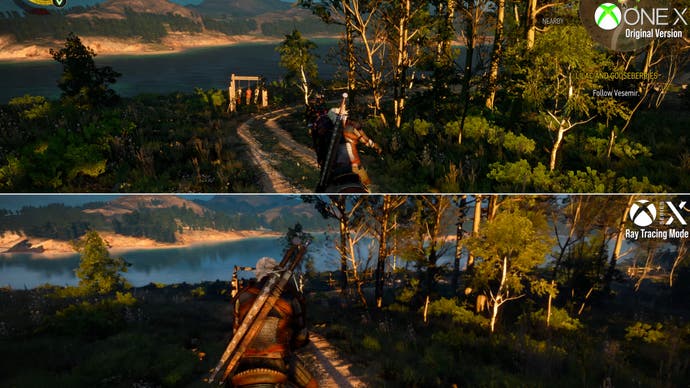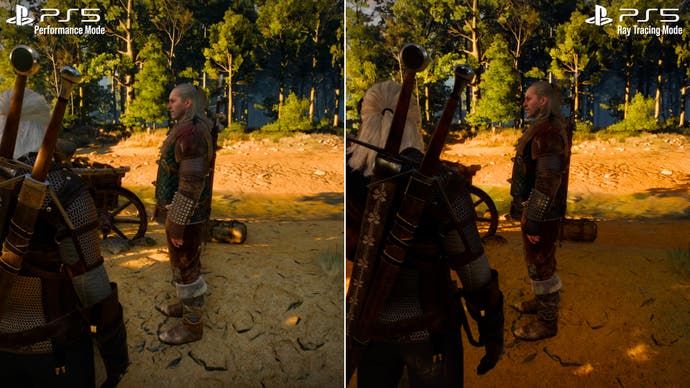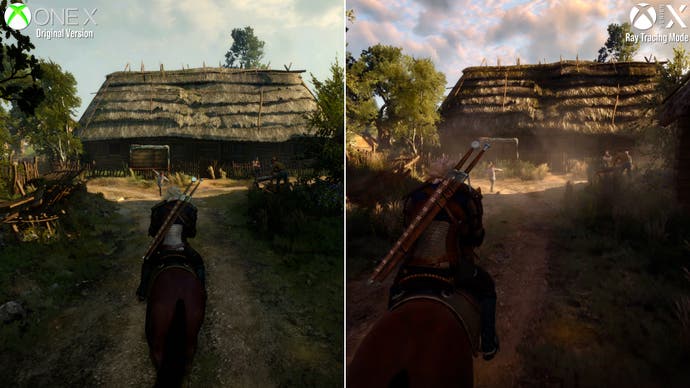Hands on with The Witcher 3's next-gen update: PS5 and Series X tested
Plus more info on the Series S and PC versions.
The Witcher 3's next-gen update arrives on 14th December, at last giving the game a proper release on PS5, Series X and Series S. And equally, it enhances the PC version with a suite of long-awaited upgrades including ray-tracing support. Seven years after the original release, after multiple expansions and a successful Netflix adaptation, this update is the perfect opportunity to craft an ultimate version for longterm fans and newcomers alike. And I'm glad to report, after flying to developer CDPR's offices in Warsaw last week to go hands on with the PS5 and Series X versions, this revitalised release very much looks to be delivering on that promise.
While we weren't allowed direct capture at the event, we were provided with footage of the first 15 minutes of the new update running on PS5 and Series X, in both their performance and RT modes - more than enough for a preview ahead of a full breakdown closer to release. As always with preview capture, it's worth stressing all of this is still being optimised and the final release may be improved further.
Still, The Witcher 3 on PS5 and Series X impressed hugely in the four hours we played it - and not just in the visual upgrades, which include reworked foliage, 4K textures and higher-quality models throughout. There are also significant quality of life improvements, like a revised camera and faster controls for using signs, the magic spells of the Witcher universe. All told, the game truly looks and plays better than ever before.
As mentioned, PS5 and Series X versions of the game offer a 60fps performance mode and a 30fps ray tracing mode, each of which uses AMD's FSR 2.1 upscaling to produce a 4K output with dynamic resolution scaling. FSR 2.1 also takes over anti-aliasing duties from the older FXAA and TAA options, providing a much more stable image as a result.
So how do these two modes hold up in practise? Starting with the 30fps ray tracing mode, we see two forms of ray tracing enabled: global illumination and ambient occlusion. The first allows lighting to bounce realistically between surfaces, shading and colouring the corners of the world, while the second ensures objects are better grounded in their surroundings with more believable shading. Together, the effects have a transformative effect on many scenes, especially those indoors or otherwise indirectly lit.






The comparisons we can show around White Orchard don't fully do the changes justice in truth, but in my time playing the game on PS5 and Series X I found the differences substantial. No doubt we'll have opportunity to show off some more compelling scenarios beyond the first 15 minutes, particularly our favourite test areas like Novigrad City and Crookback Bog.
PC users have plenty to celebrate here as well. A top-end machine will benefit from two additional RT features - reflections and shadows, completing the quartet of the most well-known RT effects. Even the premium consoles don't have enough GPU horsepower to enable all four simultaneously, so CDPR chose the two options that provided the most 'value for money', so to speak - a sensible choice, given that the environment of the Witcher is not exactly replete with the rainslick streets or glass-clad buildings that show off RT reflections so nicely in Cyberpunk.
Even with no RT reflections on console though, the 30fps mode does have enough GPU headroom to enable heavily reworked screen-space reflections (SSR), providing higher-res reflections that are also present on a wider range of surfaces, from puddles in Novigrad to the metal elements of armour.

If you prefer the responsiveness of 60fps, the performance mode is an excellent alternative that's on tap for PS5 and Series X. Regardless of mode, you still benefit from the improvements to foliage and 4K textures - so the only aspect lost here is the ray-tracing features, and the improved SSR. And while One X already had a (admittedly unstable) 60fps option, PlayStation users have until now been limited to 30fps even on PS5, due to a reliance on the PS4 Pro code, making this a more revelatory upgrade.
Performance looked good in our testing, with only a handful of dips below 60fps evident in the footage provided, although by eye the Novigrad city centre didappear to be dropping frames more heavily. This area was historically the most challenging part of the game in terms of performance - and the foundation of our Witcher GPU benchmarks on PC - so it will be fascinating to see how the new consoles and graphics cards handle the next-gen version.


Interestingly, I'm told that PC gets a new graphics preset for many settings, called Ultra Plus, which allows for even longer draw distances and denser grass, which could make The Witcher 3 a candidate for our GPU test suite even into 2023.
Beyond the graphical upgrades, there are myriad other changes and quality-of-life improvements: new weather states, higher detail self-shadows in gameplay, a new camera, a new system for casting signs, map filters, faster herb looting and content related to the Witcher TV show. It's also worth mentioning that last-gen versions of the game on PS4, Xbox One and Switch are also set to get the quality-of-life changes (sans the new camera, due to its performance impact) and the TV content, which is a nice move.


All of this is just a taster of what's to come though. From what we've seen so far, PS5 and Series X hand in near-identical delivery of the next-gen update, but we're looking forward to testing the Series S version which wasn't available in our session. We do know there are 60fps performance and 30fps quality modes on the small white console, with the latter mode offering a higher resolution but no RT.
The next-gen Update is certainly shaping up to be one of the most comprehensive free game upgrades in recent memory. It's also the last time that CDPR are expecting to use the Witcher engine, with the studio moving to Unreal Engine 5 for future releases. So it's a historic release in many respects - and a fitting wrap-up to a game that arguably remains CDPR's best work.









